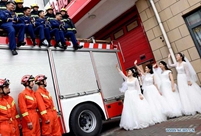

Longmen Museum
The Longmen Grottoes represent the best of Chinese Buddhist art. Located 12 kilometres south of Luoyang in central China’s Henan Province, the Longmen Grottoes site has more than 2,300 grottoes with 110,000 Buddhist figures and images, more than 80 dagobas and 2,800 inscribed tablets, all of which were created between the Northern Wei (386-557) and Song (960-1279) dynasties.
Ultimate art perfection of Tang dynasty – the Big Vairocana
The Big Vairocana (left) is the largest Buddha statue at the Longmen Grottoes. The statue is 17.14m high and has 2m long ears. (People’s Daily Online/Kou Jie)
Being the largest Buddha statue at the Longmen Grottoes, the Big Vairocana was built between 672 and 676 for China’s only empress Wu Zetian. The Vairocana image’s features are plumpish and of peaceful and natural expression, while its unparalleled beauty and magnificence is considered as the “quintessence of Buddhist sculptures in China.”
It is said that Wu Zetian donated "twenty-thousand strings of her rouge and powder money" to complete this edifice. Hence, it is conjectured that the Vairocana Buddha was carved to resemble the Empress herself, termed a "Chinese Mona Lisa, Venus or as the Mother of China.”
A filial tribute to parents – the Middle Binyang Cave
The Middle Binyang Cave was built by Emperor Xuanwu to commemorate his father Xiaowen, and also his mother. It is said that it was created between 500 to 523 by 800,000 workers.(People’s Daily Online/Kou Jie)
The Middle Binyang Cave was built by Emperor Xuanwun to commemorate his father Xiaowen, and also his mother. It is said that 800,000 workers created it over the period from 500 to 523.
In the main wall of this cave, five very large Buddhist statues are carved all in Northern Wei style. The central statue is of the Sakyamuni Buddha with four images of Bodhisattvas flanking it. Two side walls also have Buddha images flanked by Bodhisattva. The Buddhas, arranged in three groups in the cave, are representative of Buddhas of the past, the present, and the future. The canopy in the roof is designed as a lotus flower. There were two large bas-reliefs of imperial processions that included Emperor Xiaowen, Empress Dowager Wenzhao, and the emperor's late parents in worship, which were stolen in the mid-1930s. The emperor's procession is now in the Metropolitan Museum of Art in New York and two thirds of the empress's is in the Nelson-Atkins Museum of Art in Kansas City.
 |  |
 Fire brigade in Shanghai holds group wedding
Fire brigade in Shanghai holds group wedding Tourists enjoy ice sculptures in Datan Town, north China
Tourists enjoy ice sculptures in Datan Town, north China Sunset scenery of Dayan Pagoda in Xi'an
Sunset scenery of Dayan Pagoda in Xi'an Tourists have fun at scenic spot in Nanlong Town, NW China
Tourists have fun at scenic spot in Nanlong Town, NW China Harbin attracts tourists by making best use of ice in winter
Harbin attracts tourists by making best use of ice in winter In pics: FIS Alpine Ski Women's World Cup Slalom
In pics: FIS Alpine Ski Women's World Cup Slalom Black-necked cranes rest at reservoir in Lhunzhub County, Lhasa
Black-necked cranes rest at reservoir in Lhunzhub County, Lhasa China's FAST telescope will be available to foreign scientists in April
China's FAST telescope will be available to foreign scientists in April "She power" plays indispensable role in poverty alleviation
"She power" plays indispensable role in poverty alleviation Top 10 world news events of People's Daily in 2020
Top 10 world news events of People's Daily in 2020 Top 10 China news events of People's Daily in 2020
Top 10 China news events of People's Daily in 2020 Top 10 media buzzwords of 2020
Top 10 media buzzwords of 2020 Year-ender:10 major tourism stories of 2020
Year-ender:10 major tourism stories of 2020 No interference in Venezuelan issues
No interference in Venezuelan issues
 Biz prepares for trade spat
Biz prepares for trade spat
 Broadcasting Continent
Broadcasting Continent Australia wins Chinese CEOs as US loses
Australia wins Chinese CEOs as US loses